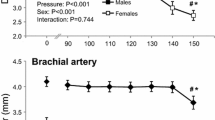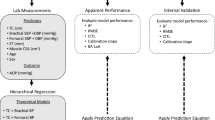Abstract
Purpose
Arterial occlusion pressure (AOP) measured in a supine position is often used to set cuff pressures for blood flow restricted exercise (BFRE). However, supine AOP may not reflect seated or standing AOP, thus potentially influencing the degree of occlusion. The primary aim of the study was to investigate the effect of body position on AOP. A secondary aim was to investigate predictors of AOP using wide and narrow cuffs.
Methods
Twenty-four subjects underwent measurements of thigh circumference, skinfold and blood pressure, followed by assessments of thigh AOP in supine and seated positions with a wide and a narrow cuff, respectively, using Doppler ultrasound.
Results
In the supine position, AOP was 148 ± 19 and 348 ± 94 mmHg with the wide and narrow cuff, respectively. This increased to 177 ± 20 and 409 ± 101 mmHg in the seated position, with correlations between supine and seated AOP of R 2 = 0.81 and R 2 = 0.50 for the wide and narrow cuff, respectively. For both cuff widths, thigh circumference constituted the strongest predictor of AOP, with diastolic blood pressure explaining additional variance with the wide cuff. The predictive strength of these variables did not differ between body positions.
Conclusion
Our results indicate that body position strongly influences lower limb AOP, especially with narrow cuffs, yielding very high AOP (≥ 500–600 mmHg) in some subjects. This should be taken into account in the standardization of cuff pressures used during BFRE to better control the physiological effects of BFRE.


Similar content being viewed by others
Abbreviations
- AOP:
-
Arterial occlusion pressure
- BFRE:
-
Blood flow restricted exercise
- BMI:
-
Body mass index
- DBP:
-
Diastolic blood pressure
- SBP:
-
Systolic blood pressure
References
Clark BC, Manini TM, Hoffman RL, Williams PS, Guiler MK, Knutson MJ, McGlynn ML, Kushnick MR (2011) Relative safety of 4 weeks of blood flow-restricted resistance exercise in young, healthy adults. Scand J Med Sci Sports 5:653–662. https://doi.org/10.1111/j.1600-0838.2010.01100.x
Cook SB, Clark BC, Ploutz-Snyder LL (2007) Effects of exercise load and blood-flow restriction on skeletal muscle function. Med Sci Sports Exerc 10:1708–1713. https://doi.org/10.1249/mss.0b013e31812383d6
Cook SB, LaRoche DP, Villa MR, Barile H, Manini TM (2017) Blood flow restricted resistance training in older adults at risk of mobility limitations. Exp Gerontol. https://doi.org/10.1016/j.exger.2017.10.004
Crenshaw AG, Hargens AR, Gershuni DH, Rydevik B (1988) Wide tourniquet cuffs more effective at lower inflation pressures. Acta Orthop Scand 4:447–451. https://doi.org/10.3109/17453678809149401
Eiken O (1988) Effects of increased muscle perfusion pressure on responses to dynamic leg exercise in man. Eur J Appl Physiol Occup Physiol 6:772–776
Fahs CA, Loenneke JP, Thiebaud RS, Rossow LM, Kim D, Abe T, Beck TW, Feeback DL, Bemben DA, Bemben MG (2015) Muscular adaptations to fatiguing exercise with and without blood flow restriction. Clin Physiol Funct Imaging 3:167–176. https://doi.org/10.1111/cpf.12141
Farup J, de Paoli F, Bjerg K, Riis S, Ringgard S, Vissing K (2015) Blood flow restricted and traditional resistance training performed to fatigue produce equal muscle hypertrophy. Scand J Med Sci Sports 6:754–763. https://doi.org/10.1111/sms.12396
Folkow B, Haglund U, Jodal M, Lundgren O (1971) Blood flow in the calf muscle of man during heavy rhythmic exercise. Acta Physiol Scand 2:157–163. https://doi.org/10.1111/j.1748-1716.1971.tb04887.x
Graham B, Breault MJ, McEwen JA, McGraw RW (1993) Occlusion of arterial flow in the extremities at subsystolic pressures through the use of wide tourniquet cuffs. Clin Orthop Relat Res 286:257–261
Hughes L, Paton B, Rosenblatt B, Gissane C, Patterson SD (2017) Blood flow restriction training in clinical musculoskeletal rehabilitation: a systematic review and meta-analysis. Br J Sports Med. https://doi.org/10.1136/bjsports-2016-097071
Ingram JW, Dankel SJ, Buckner SL, Counts BR, Mouser JG, Abe T, Laurentino GC, Loenneke JP (2017) The influence of time on determining blood flow restriction pressure. J Sci Med Sport. https://doi.org/10.1016/j.jsams.2016.11.013
International Society for the Advancement of Kinanthropometry (2001) International standards for anthropometric assessment. National Library, Australia
Karabulut M, Bemben DA, Sherk VD, Anderson MA, Abe T, Bemben MG (2011) Effects of high-intensity resistance training and low-intensity resistance training with vascular restriction on bone markers in older men. Eur J Appl Physiol 8:1659–1667. https://doi.org/10.1007/s00421-010-1796-9
Laurentino G, Ugrinowitsch C, Aihara AY, Fernandes AR, Parcell AC, Ricard M, Tricoli V (2008) Effects of strength training and vascular occlusion. Int J Sports Med 8:664–667. https://doi.org/10.1055/s-2007-989405
Laurentino GC, Ugrinowitsch C, Roschel H, Aoki MS, Soares AG, Neves M Jr, Aihara AY, Fernandes AdRC, Tricoli V (2012) Strength training with blood flow restriction diminishes myostatin gene expression. Med Sci Sports Exerc 3:406–412. https://doi.org/10.1249/MSS.0b013e318233b4bc
Lixandrão ME, Ugrinowitsch C, Laurentino G, Libardi CA, Aihara AY, Cardoso FN, Tricoli V, Roschel H (2015) Effects of exercise intensity and occlusion pressure after 12 weeks of resistance training with blood-flow restriction. Eur J Appl Physiol 12:2471–2480. https://doi.org/10.1007/s00421-015-3253-2
Loenneke JP, Fahs CA, Rossow LM, Sherk VD, Thiebaud RS, Abe T, Bemben DA, Bemben MG (2012) Effects of cuff width on arterial occlusion: implications for blood flow restricted exercise. Eur J Appl Physiol 8:2903–2912. https://doi.org/10.1007/s00421-011-2266-8
Loenneke JP, Thiebaud RS, Fahs CA, Rossow LM, Abe T, Bemben MG (2013) Effect of cuff type on arterial occlusion. Clin Physiol Funct Imaging 4:325–327. https://doi.org/10.1111/cpf.12035
Loenneke JP, Thiebaud RS, Abe T, Bemben MG (2014) Blood flow restriction pressure recommendations: the hormesis hypothesis. Med Hypotheses 5:623–626. https://doi.org/10.1016/j.mehy.2014.02.023
Loenneke JP, Allen KM, Mouser JG, Thiebaud RS, Kim D, Abe T, Bemben MG (2015) Blood flow restriction in the upper and lower limbs is predicted by limb circumference and systolic blood pressure. Eur J Appl Physiol 2:397–405. https://doi.org/10.1007/s00421-014-3030-7
Loenneke JP, Kim D, Fahs CA, Thiebaud RS, Abe T, Larson RD, Bemben DA, Bemben MG (2016) The influence of exercise load with and without different levels of blood flow restriction on acute changes in muscle thickness and lactate. Clin Physiol Funct Imaging. https://doi.org/10.1111/cpf.12367
Mattar MA, Gualano B, Perandini LA, Shinjo SK, Lima FR, Sá-Pinto AL, Roschel H (2014) Safety and possible effects of low-intensity resistance training associated with partial blood flow restriction in polymyositis and dermatomyositis. Arthritis Res Ther 5:473. https://doi.org/10.1186/s13075-014-0473-5
Mouser JG, Dankel SJ, Jessee MB, Mattocks KT, Buckner SL, Counts BR, Loenneke JP (2017) A tale of three cuffs: the hemodynamics of blood flow restriction. Eur J Appl Physiol 7:1493–1499. https://doi.org/10.1007/s00421-017-3644-7
Nielsen JL, Aagaard P, Bech RD, Nygaard T, Hvid LG, Wernbom M, Suetta C, Frandsen U (2012) Proliferation of myogenic stem cells in human skeletal muscle in response to low-load resistance training with blood flow restriction. J Physiol 17:4351–4361. https://doi.org/10.1113/jphysiol.2012.237008
Noordin S, McEwen JA, Kragh JF Jr, Eisen A, Masri BA (2009) Surgical tourniquets in orthopaedics. J Bone Joint Surg Am 12:2958–2967. https://doi.org/10.2106/JBJS.I.00634
Sumide T, Sakuraba K, Sawaki K, Ohmura H, Tamura Y (2009) Effect of resistance exercise training combined with relatively low vascular occlusion. J Sci Med Sport 1:107–112. https://doi.org/10.1016/j.jsams.2007.09.009
Takarada Y, Takazawa H, Sato Y, Takebayashi S, Tanaka Y, Ishii N (2000) Effects of resistance exercise combined with moderate vascular occlusion on muscular function in humans. J Appl Physiol 6:2097–2106
Tennent DJ, Hylden CM, Johnson AE, Burns TC, Wilken JM, Owens JG (2016) Blood flow restriction training after knee arthroscopy: a randomized controlled pilot study. Clin J Sport Med. https://doi.org/10.1097/JSM.0000000000000377
Wall PL, Duevel DC, Hassan MB, Welander JD, Sahr SM, Buising CM (2013) Tourniquets and occlusion: the pressure of design. Mil Med 5:578–587. https://doi.org/10.7205/MILMED-D-12-00490
Wall PL, Sahr SM, Buising CM (2015) Different width and tightening system: emergency tourniquets on distal limb segments. J Spec Oper Med 4:28–38
Acknowledgements
The study was not supported by any funding.
Author information
Authors and Affiliations
Corresponding author
Ethics declarations
Conflict of interest
The authors declare that they have no conflict of interest.
Additional information
Communicated by William J. Kraemer.
Electronic supplementary material
Below is the link to the electronic supplementary material.
Rights and permissions
About this article
Cite this article
Sieljacks, P., Knudsen, L., Wernbom, M. et al. Body position influences arterial occlusion pressure: implications for the standardization of pressure during blood flow restricted exercise. Eur J Appl Physiol 118, 303–312 (2018). https://doi.org/10.1007/s00421-017-3770-2
Received:
Accepted:
Published:
Issue Date:
DOI: https://doi.org/10.1007/s00421-017-3770-2




